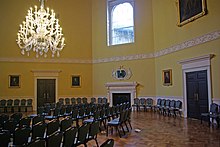This article needs additional citations for verification. (February 2024) |

In Great Britain and Ireland, especially in the 18th and 19th centuries, assembly rooms were gathering places for members of the higher social classes open to members of both sexes.[1][2] At that time most entertaining was done at home and there were few public places of entertainment open to both sexes besides theatres (and there were few of those outside London). Upper class men had more options, including coffee houses and later gentlemen's clubs.[3]
Major sets of assembly rooms in London, in spa towns such as Bath, and in important provincial cities such as York, were able to accommodate hundreds, or in some cases over a thousand people for events such as masquerade balls (masked balls), assembly balls (conventional balls), public concerts and assemblies (simply gatherings for conversation, perhaps with incidental music and entertainments) or Salons. By later standards these were formal events: the attendees were usually screened to make sure no one of insufficient rank gained admittance; admission might be subscription only; and unmarried women were chaperoned. Nonetheless, assemblies played an important part in the marriage market of the day.
A major set of assembly rooms consisted of a main room and several smaller subsidiary rooms such as card rooms, tea rooms and supper rooms. On the other hand, in smaller towns a single large room attached to the best inn might serve for the occasional assembly for the local landed gentry.
By the 1900s, people became more accepting of women entering public places, and new venues for entertainment arose, such as public dance halls and nightclubs.[3] Also to some extent they were supplanted by the ballrooms of major hotels as British hotels became larger from the railway age onwards.